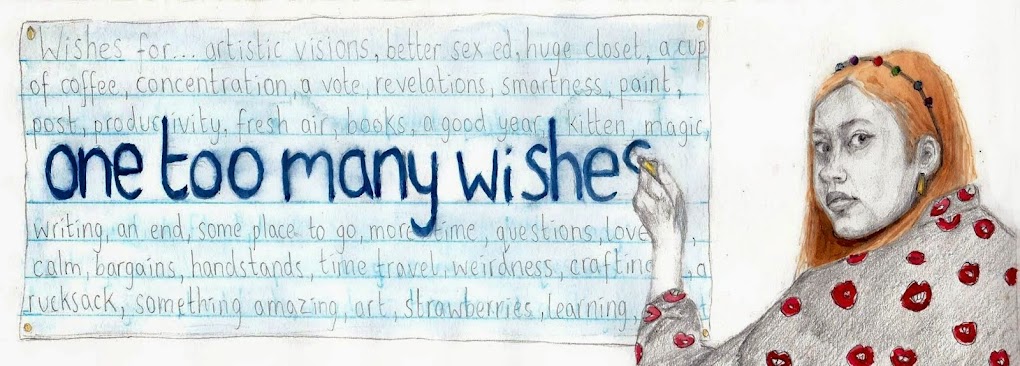Almost 2 years ago I took it upon myself to learn how to embroider for an art project. After I grappled with the basics myself, the internet became a great resource for stitch tutorials and inspirational artistic embroideries; Yet I never did find an informative piece that threaded together those simple basics I taught myself. And so, let us begin.
Embroidery is fairly simple, and whilst can be time consuming, it doesn't have to be. For example it took me 1 hour to sew the words 'You spin me right round baby' onto my dancing skirt, whereas it took closer to 10 hours to sew the skirt itself (dramatically increased by the fact that I don't have a sewing machine). Embroidery doesn't have to be about precise measurements or neatness, instead it can be more about quickly adding an element of fun decoration to something. Yet for the more ambitious it can also be used to create intricate artwork, like that of Ana Teresa Barboza. Either way, both use the same set of tools and skills.
What you'll need (from left to right)
Fabric- Start with a cotton or polyester, rather than a heavy fabric or a delicate sheer fabric that might tear. With experience you can begin to experiment and even try working on non-fabric surfaces (eg paper)
Scissors- Fabric scissors are extra sharp, but are totally optional for embroidery.
Needle- I just use a normal one with a large eye (the hole at the top), though you can invest in an embroidery needle.
Embroidery Thread (also known as Floss)- Other thread can be used, but investing in embroidery thread is highly recommended. It's softer, gives a much better finish, comes in a great variety of colours and most importantly can be separated, which will become clear in the next part. You can buy one colour from 25p or bundles of 50 colours for around £6 online and the stuff with last you a long time.
Embroidery Hoop- These come in various size and the quality doesn't really matter. It's probably best to start with a small or medium sized hoop (19cm) for about £1.50.
Once you've got your equipment, there's only 2 basic things you need to know about- the thread and the hoop.
The Thread- Embroidery thread is generally made up of 6 threads twined together. You're probably going to want to separate those threads otherwise your stitches will look bulky and won't lay tightly on the surface of your fabric (like the lettering I did above in a rush). So first cut yourself no more than an arms length of thread and then rub your fingers on one end: You'll easily see the separate strands. With your fingers you can separate the thread into 2 sets of three strands (you're best bet at first) or three sets of two strands. Thread you're needle with one set of strands, no need to tie a knot.
The Hoop- Your embroidery hoop is made up of two hoops- an outer one with an adjustable screw and an inner hoop.
1.Start with a piece of fabric with a width at least 10 cm larger than the diameter of your hoop.
2.Fully loosen the screw on your outer hoop, then lay your fabric on top of the hoop. Then place your inner hoop on top of the fabric, inside the outer hoop, to make a sandwich.
3.Now tighten the screw till it's almost fully screwed.
4. Now tug at the edges of the fabric all the way round the hoop, then tighten the screw a little. Repeat this process a few times until your screw is fully tightened and the fabric is flat and taught within the hoop.
It's easiest to embroider onto a flat piece of fabric than a finished garment, as garments are harder to get taught in the hoop. So if you're having difficulties, you can always embroider onto your separate piece of fabric and then sew this onto a garment like a patch.
Embroidery Stitches (FINALLY!)
There are many different stitches that can be learned, but you can create all sorts of designs just by knowing one stitch. So here I'll introduce you to a few basic ones.
Straight Stitch- So this is basically the stitch most people know if they've ever had to sew anything before. So you probably wont even need to learn how to do it, and even if you do, you'll have figured it out in 2 secs. Heres a tutorial. You can use this to 'fill in' shapes a bit like colouring in (and like colouring in, it's easier if you draw your shapes onto the fabric in pencil first) and you'll never have to use another stitch. I've used it above for the waves, sea and eyes.
Split Stitch- This one is great for outlines or writing neat letters, like the ones on my skirt or the ones above. Here's a tutorial. The above design was done using only a straight stitch and split stitch.
Lazy Daisy- The name says it all. Great for daisy petals but could be used for anything, tear drops, raindrops, snot drops. Heres a tutorial.
French Knot- This ones a little more complicated, but it's nice for the 3D effect it gives. I used it to make the centre of my daisy more interesting but it's also great to know this one for tying off the end of your thread. Heres a tutorial.
You can find many more stitch tutorials online, but hopefully this has threaded those basics together for you. If you're still puzzled you can ask me any questions below, and if you still need some embroidery inspiration I'll probably be writing up something about that soon too.















